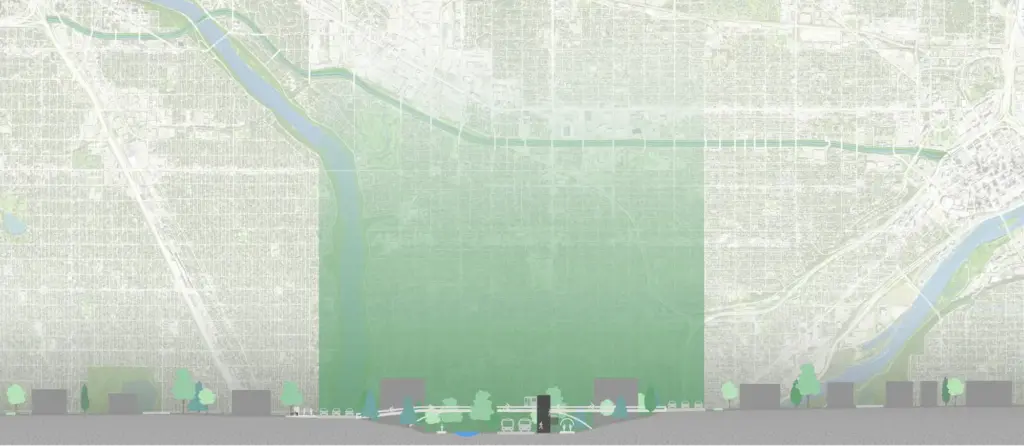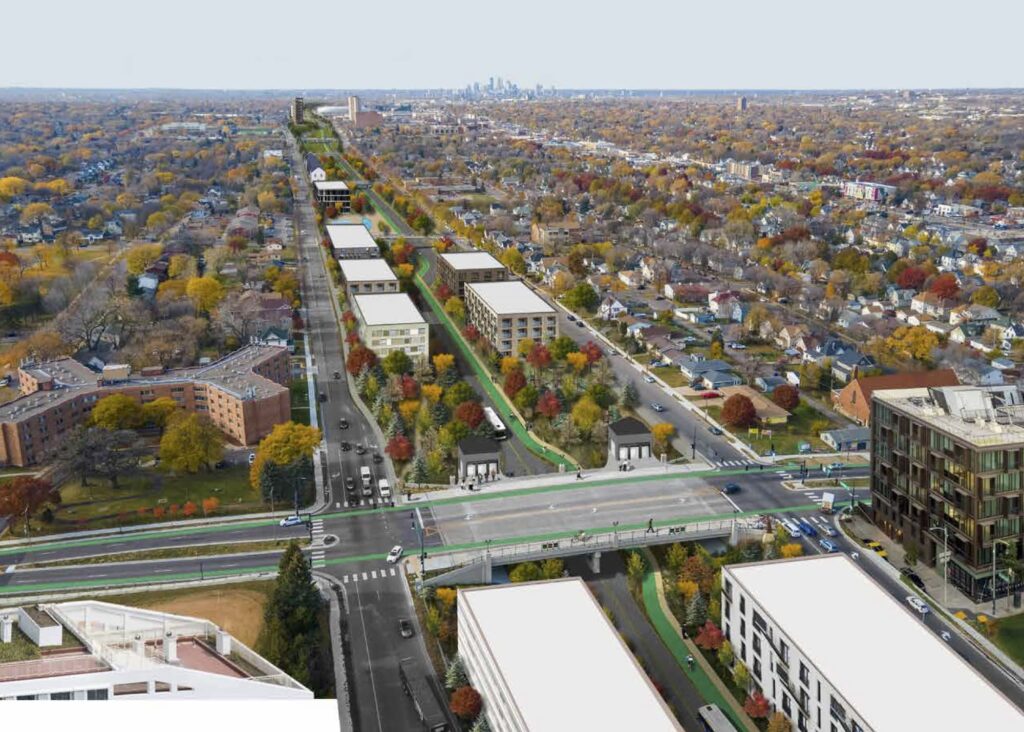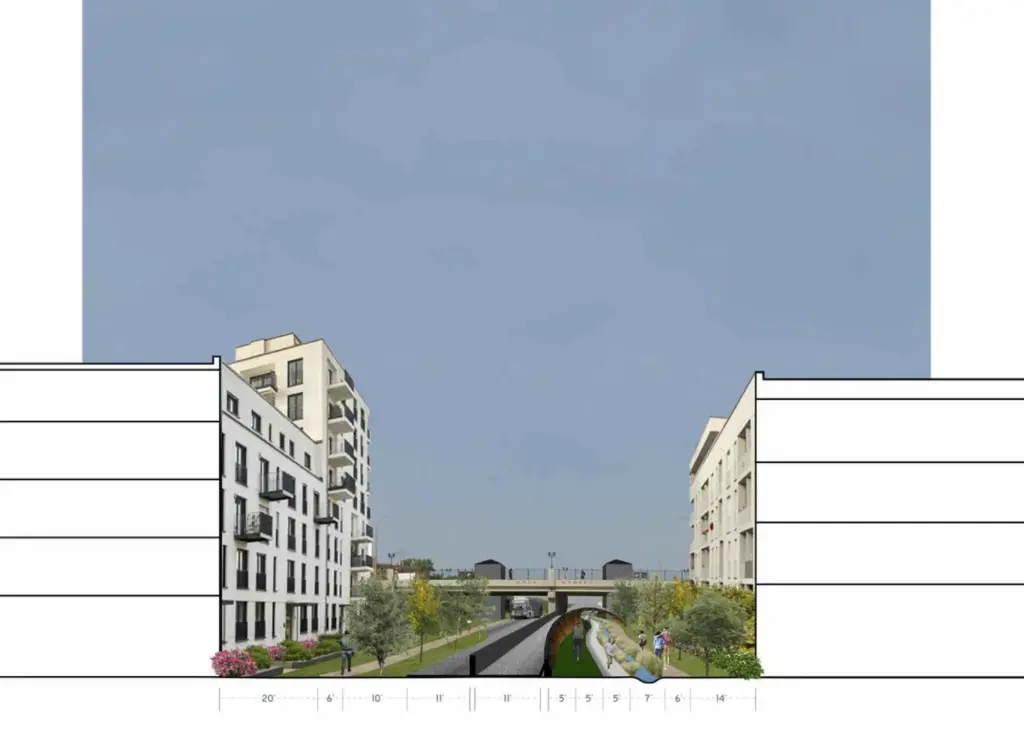
MnDOT is currently seeking feedback on project options for Rethinking I-94. Here are some tips for filling it out to support Twin Cities Boulevard.
The Minnesota Department of Transportation (MnDOT) unveiled the initial project options for the Rethinking I-94 project during the project’s Policy Advisory Committee meeting on July 17. A public survey is open through the summer to collect feedback on the initial project options. MnDOT included two boulevard conversion options, called “at-grade”, a major step toward making Twin Cities Boulevard a reality.

We need you to complete the survey and share your support for these two “at-grade” options. In addition, let MnDOT know what ideas and considerations are missing. The survey covers a range of topics, so read more to learn about the survey questions and suggested comments to support Twin Cities Boulevard.
The survey is broken up into six sections.
The beginning and the end of the survey are fairly self-explanatory. The questions ask about you, how you interact with the I-94 corridor, and how you would like to be engaged during future project steps.
The middle of the survey is the most critical. MnDOT asks for feedback on each proposed project option, which MnDOT calls “alternatives”. The following questions are listed for each alternative:
- Overall, what do you like about this Alternative option?
- Overall, what could be improved with this Alternative option?
- Any other general comments, reactions, questions, concerns?
“At-grade A” and ‘At-grade B” are the boulevard conversion options. These options would replace the freeway with an at-grade boulevard with bus rapid transit. MnDOT has clarified that these are high-level designs and that additional details about the boulevard and what the repurposed land would be used for would be determined in future steps.
The renderings in MnDOT’s survey are not to scale and misleadingly make the at-grade options appear to occupy the same footprint as the freeway options. The below images show a reasonable to-scale comparison near Allianz Field in Saint Paul.

Sharing Your Support of At-Grade A & B Alternatives
For both boulevard conversion options (“at-grade A” & “at-grade B”):
- Share that a boulevard conversion is your preferred option
- Mention the benefits of a boulevard conversion
- Cleaner air, less traffic noise and improved public health
- Reduced greenhouse gas emissions
- Improved transportation access for people without cars
- Walkable shops, parks and reconnected communities
- Improved access to local businesses
- New affordable housing
- Lower long-term maintenance costs and increased tax revenue for public services
- Suggest how the boulevard options could be improved
- What features would you like to see included?
- XXXAll boulevard conversion options should return land to the community and should be designed to be safe and easy to crossX
Opposing Rebuild and Expansion Alternatives
For the options that would rebuild and/or expand the highway (every other option):
- State that rebuilding the highway is unacceptable and would perpetuate injustice. MnDOT has a responsibility to repair historic and ongoing harms
- Mention some of the ways that I-94 harms its neighbors and our broader community:
- Thousands of homes and businesses were destroyed in Saint Paul and Minneapolis
- Air and noise pollution and significant health disparities
- Divided neighborhoods
- Transportation is Minnesota’s biggest contributor to the climate crisis
- I-94’s pavement worsens extreme heat
- Restricted transportation access for people without cars
- The highway is expensive to maintain and wastes land that could be better used
- Highways only make traffic congestion worse
Missing Project Alternatives
Question 30 asks, what alternatives should be added? MnDOT stated additional options may be added based on feedback. This is an opportunity to demand a wide variety of options that remove the highway and return land to the community.
Here are some suggested comments:
- Add a boulevard conversion option with a subway. Below-ground transit would ensure maximum speed and reliability while freeing up more space for new housing, parks and businesses. MnDOT should continue to study this option.
- Add options that remove the highway but keep a portion of the trench for transit. Reimagining the highway can take a number of forms. Our Streets Minneapolis has communicated the reasons why we believe that an at-grade boulevard that fills in the trench is the best way to reconnect neighborhoods, however, it is critical that the community can consider every possible option for reimagining the highway, including options that remove the highway but preserve the trench for transit. Currently, this is not included in MnDOT’s listed options. The below images show what an option could look like that uses the trench for a new busway, bikeway, walking trails, and park space, while building new housing into the trench walls. These designs and renderings were created by Josiah Gregg as part of a project to reimagine urban freeways at the Harvard Graduate School of Design.



Rethinking I-94 should also study projects within the broader corridor that support the project’s goals. This includes:
- Expanding the project area to include repurposing a portion of Highway 280, which would become obsolete if I-94 was removed. This would reconnect Saint Anthony Park and create new space for parks, housing and businesses.
- Studying connecting Pierce Butler Route and Energy Park Drive to serve as a freight alleviator for surrounding industry. This idea has been studied in the past and could be a way to improve freight access and keep trucks off of neighborhood streets.
- Extending the Midtown Greenway across the Mississippi River and through Saint Paul. A greenway extension would run parallel to I-94, making it significantly easier to bike between cities. MnDOT should include a greenway extension within the program of Rethinking I-94 projects.
What information should MnDOT provide about each project option?
Question 31 of the survey asks for information that is important for the public to know about each option. It is critical that community members are fully informed about how the existing highway and each proposed project option would impact their lives.
Here are some suggested comments to include:
- MnDOT should create multiple to-scale renderings for each project option to help the public visualize what it would look like in their neighborhood
- MnDOT should make it clear how each project option would impact air pollution, noise pollution and public health
- MnDOT should outline how each project option would impact racial equity and environmental justice
- MnDOT should make it clear how each project option would impact climate and vehicle miles traveled goals
- MnDOT should show the amount of land that each project option would repurpose for new housing, business, and parks
- MnDOT should calculate the long-term maintenance costs of each option
- Traffic and transit modeling for the boulevard options should consider the impact of repurposing land for new development
- MnDOT should include information about what happened to traffic congestion and economic development after previous highway removal projects
- MnDOT should present information about induced demand
MnDOT’s Livability Framework
Question 32 of the survey asks about MnDOT’s “livability framework”. This is a set of high-level goals that MnDOT’s claims they will use to measure how their projects impact surrounding communities. However we have serious concerns about how these goals will be applied and are concerned that they will have little impact on the evaluation process.
Here are some suggested comments and questions:
- It is not clear how the livability framework will be applied. How will livability for surrounding communities be weighed against the measures the MnDOT typically uses like vehicle capacity?
- What specific metrics is MnDOT using to evaluate each livability goal?
Have you started the survey and still have questions? We are here to help! Feel free to email Alex Burns at alex@ourstreetsmpls.org.